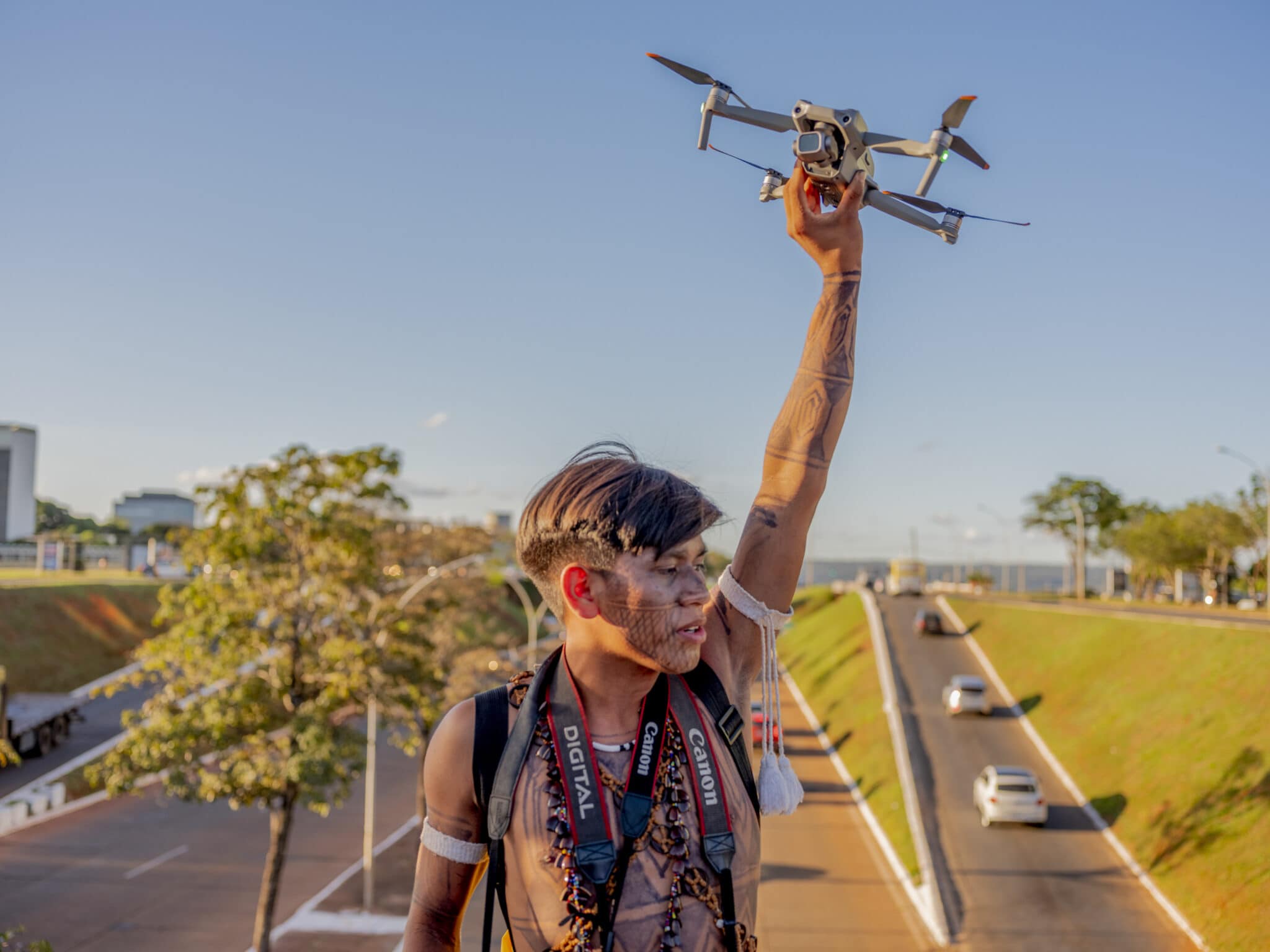
Never again will indigenous voices be silenced
On April 24, the 19th version of the Acampamento Terra Livre (ATL), the largest and most important annual indigenous mobilization in Brazil, began in Brasília. This year, one of the topics of discussion was indigenous communication. Young indigenous people from all regions of the country do the event’s media coverage. Many of them have been trained by other young people, and together, they think of their role as a mission and communication tool in the struggle to defend indigenous rights and territories. This report presents eight communicators we met this year in the Brazilian capital.
By Marcela Vallejo / Photographs by Musuk Nolte
“Where are the iPhone indigenous people?” asked José Cláudio Camargo, Tupi Guarani indigenous communicator. He did so when he began his speech at the plenary “The importance of indigenous communication and technology in decolonization, denunciation, and struggle” during the 19th Acampamento Terra Livre (ATL). Almost all of the plenary audience raised their hands at the question, some even holding their cell phones. Camargo said that many white people think indigenous people who use cameras, cell phones, and microphones are no longer indigenous. With that idea and the intensity of the response to her question, Camargo was blunt: “Being indigenous has nothing to do with using these tools.”
As the plenary unfolded, cameras and cell phones, operated mainly by indigenous youth, were pointed at the people who would speak. For several years the ATL’s media coverage has been collaborative and made by communicators who come to Brasilia from different parts of the country, belong to various indigenous peoples, and speak, in addition to Portuguese, other languages. Alexandre Pankararu, from the Pankararu people, began by telling how, since the 2000s, they have strongly developed their alternative form of communication, far from folkloristic visions. He, at 50 years old, was the most senior panelist.
The plenary was long because something happened that had yet to ever occur in the others, but which all those who have participated in previous camps point out as a characteristic feature of the ATLs. Shortly after it began, representatives of the Pataxó people arrived to open the table with a dance and a song. Two more participants spoke, and the Xakriabá people came, and shortly after, when the third participant had spoken, the Xucurú people arrived with flutes, songs, and seeds for all.
“The ATL is like this,” said Samela Sateré, influencer, and communicator of the Articulação dos Povos Indígenas do Brasil (APIB), “it is full of culture, dance, and music.” Samela led the plenary and was in charge of coordinating the official communication of the camp. She and those invited to share experiences agreed that communication is a tool of struggle. Mitã Xipaya, the coordinator of the Network of Indigenous Communicators of the Coordination of Indigenous Organizations of the Brazilian Amazon (COIAB), insisted that native peoples have been communicators since their beginnings. The difference now is the use of new information and communication technologies. And this is not the only way to communicate; Yana Faria, an indigenous Terena, also recalled the importance of radio in territories where internet connection is scarce and of poor quality.
The plenary allowed listening to communicators who have experience in the field and who gather reflections from the national indigenous movement. Ricardo Baraviera of the Terena people expressed one of these reflections, he pointed out that one of the characteristics of indigenous communication is that it is never neutral, nor does it pretend to be. It has explicit purposes: it builds new narratives while deconstructing some old ones.
The vanguard of the ancestral
Many indigenous communicators agree that the challenges they face are the lack of equipment, which they can solve to some extent with access to cell phones, and the difficulty in accessing the Internet. In addition, they face the challenge of learning to tell stories and create new narratives without reviewing each culture’s secrecy and sacredness.
The latter was made clear by Erisvan Guajajara, a member of the Mídia Indígena collective, perhaps one of Brazil’s most recognized and respected indigenous communication collectives. Until recently, they were Mídia India; they changed the name a few weeks ago after a series of discussions and reflections that led them to consolidate their new name to recognize that the word “Indian” has a racist and colonial charge. But also by understanding that they have already “won and delimited” a space among the media and that now they can impose a good name to refer to the native peoples of the country.
The plenary gave us a panoramic view of indigenous communication: most communicators are young and very close to indigenous organizations such as APIB and COIAB, and they all recognize in the exercise of communicating a tool for visibility, creation, struggle, and resistance.
In this special, we would like to introduce you to eight communicators we met during the 19th version of ATL, Brazil’s most significant and crucial indigenous mobilization. In their voices, the struggle of their people is guaranteed.
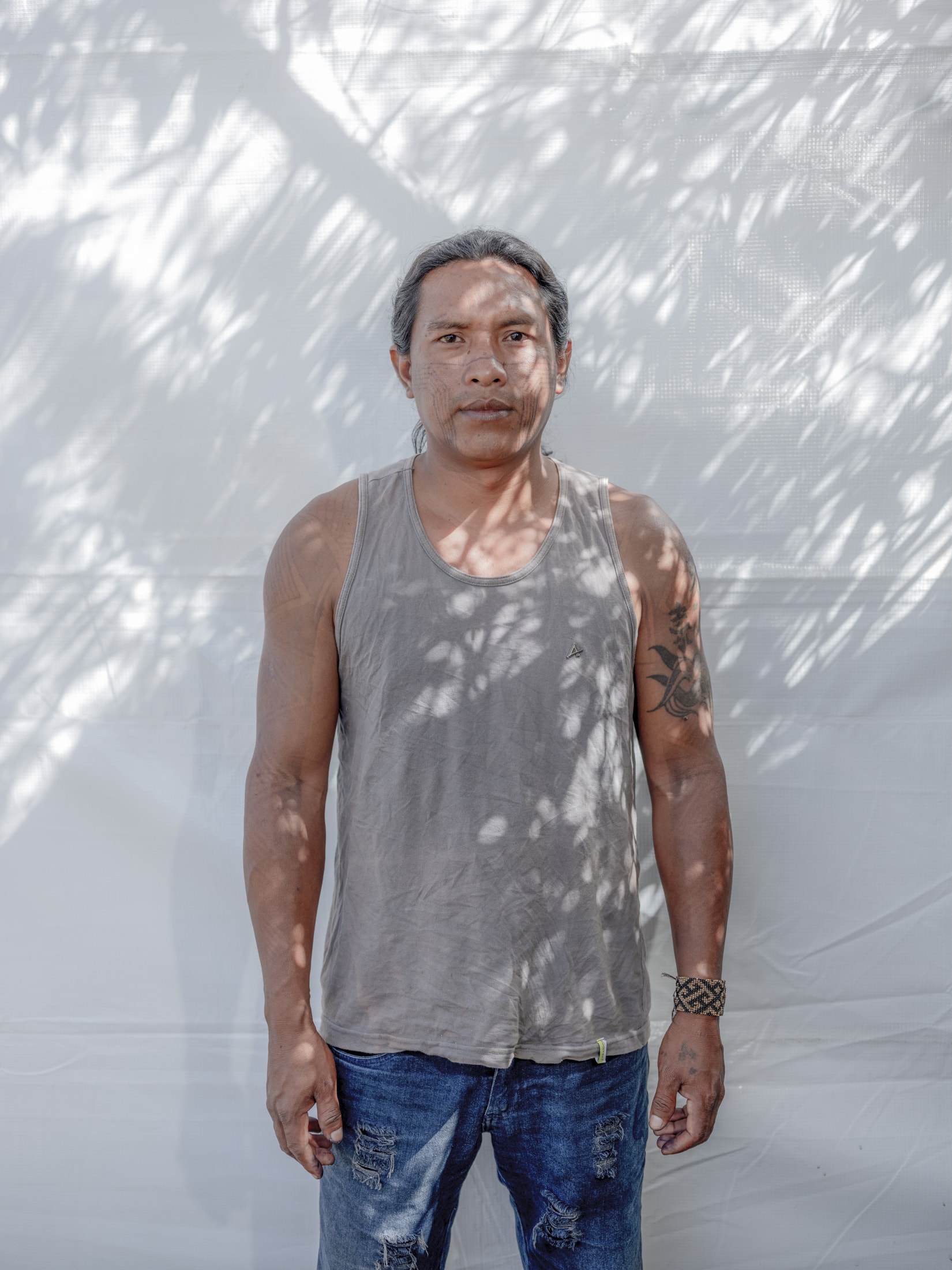
Flay Guajajara
35 years old
Cacique, member of Guardiões da Floresta and filmmaker in Mídia Indígena Guajajara people, indigenous territory Arariboia (Maranhão)
“One of the first times my dad took me to the city, I saw another world and many photos; that’s when I fell in love with photography. Besides, I had photographic records of my childhood, which always seemed significant and influential. Since I was a child, I decided I wanted to do that. So, in 2009, I talked to Sonia [Guajajara] and my cousins and proposed that we have a communication process in our territory. Shortly after, she called me from her work at APIB to train me as a communicator, participating in the Alma Brasileira-Coisa de Indio project. That space allowed me and others to train and create our collective: Mídia India, which started in 2017. A means of communication of what happens in our organizations and our villages is now called Mídia Indígena.
In my territory, Arariboia, we, the Guajajara, inhabit and also an isolated people called Awa Guajajá. This area of 413,000 hectares of forest has already been affected by the construction of three highways and a railroad, which divided our territory and allowed the entry of different types of invaders. In response to that, with my relatives, we created the group Guardiões da Floresta (Guardians of the Forest), and with them, we are initiating training processes in communication. One of the films I made that touches a little on our work with the Guardians is called Ka’a Zar Ukyze Wà (Os Donos da Floresta em Perigo).”
André Guajajara
19 years old
Official photographer of federal deputy Célia Xakriabá Guajajara Village, Pindaré indigenous territory (Maranhão)
IG: @oguajajara
“I was born in the state of Maranhão, in the Pindaré indigenous land, but I moved to the state of Pará to my father’s land, and then, due to lack of work, I went to the village of the Gavião people in the Mãe Maria indigenous land in Tocantins. That’s where my story with photography began. Between 2019 and 2021, I started to record the festivities and cultural traditions of the Gavião people. I did the coverage with a friend, and we used only cell phones at that time. Little by little, we got the equipment, first a camera for me and then another for him.
In 2022 APIB contacted us and invited us to cover that year’s ATL. That invitation opened many doors for us. We have traveled to Europe, and we have worked with COIAB. At the beginning of this year, federal deputy Célia Xakriabá invited me to be her photographer, and it has been a period of much learning. Our work is essential because we resist every day. Our struggle is daily against logging, mining, agribusiness, and many times against the government that wants to take us off our lands.”
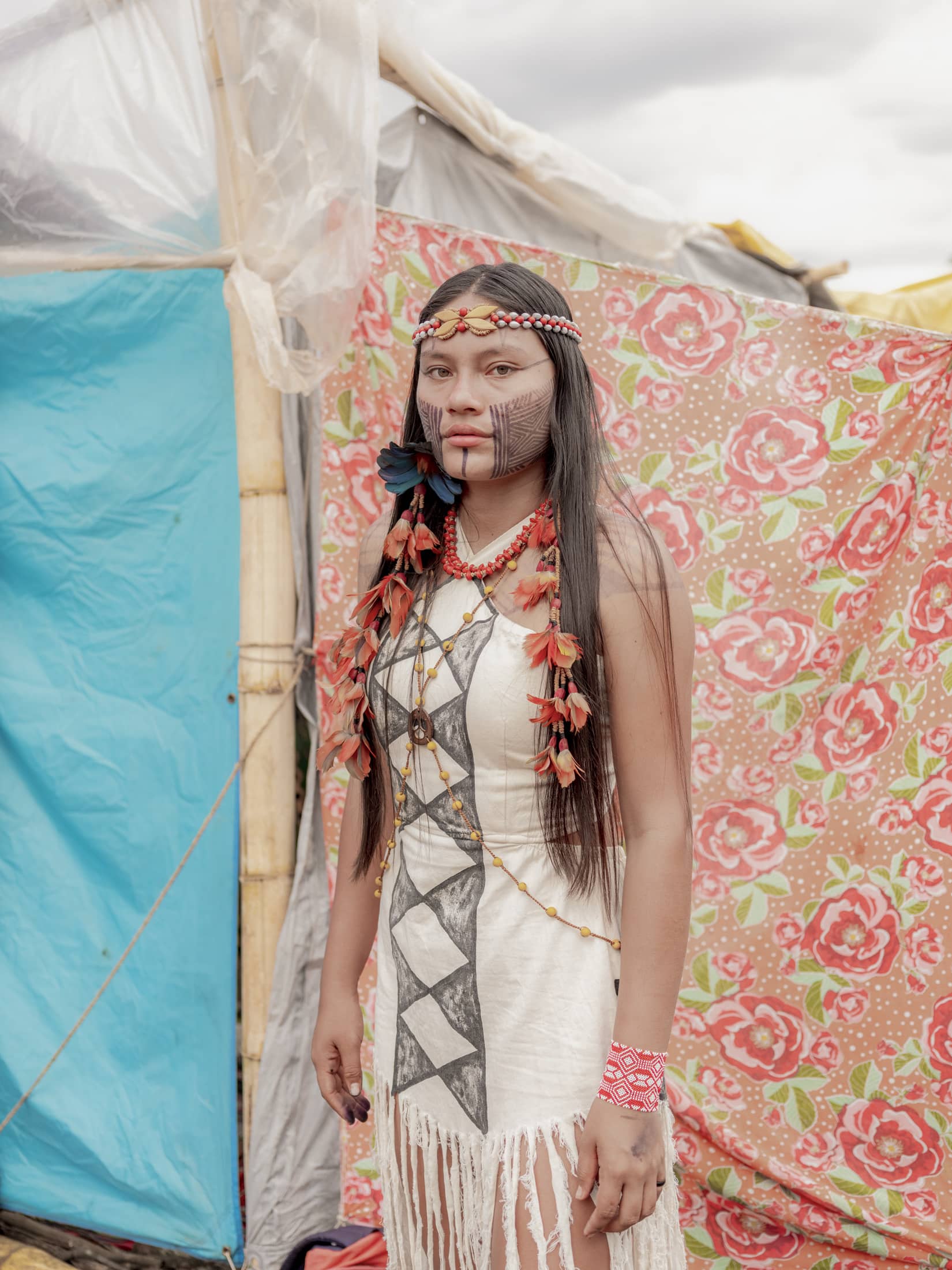
Tainara Kambeba
18 years old
She is an influencer and communicator of the Indigenous Women’s network of the State of Amazonas (Makira E’ta).
Cambeba Village, Manaus
IG: @tainara_kambeba
“I entered the world of communication when I was nine, so this is my passion. I intend to study journalism to continue working for my people in defense of our territories and our indigenous peoples. When I was 15 years old, I started training to do podcasts, to know how to use a camera or a microphone. Thanks to the Network of Women of the State of Amazonas, Makira E’ta, I entered more firmly into activism, which is also part of indigenous communication.
Now I am 18, and I am an indigenous communicator. Since I am, I have also opened an Instagram account to show a little of my territory and my work. I maintain close and solid relationships with the leaders of my community because when I go out there, I represent not only my people but also the leaders. We maintain constant exchanges and a tacit agreement that I will share what I have learned with my community when I return. In that way, I have also conducted some workshops with young people, and we are creating a network of communicators.”
Ahi Pitsalu Naia Wauja
19 years old
Photographer of the Xingu Indigenous Lands Association (ATIX) and the Women’s Movement of the Xingu Indigenous Territory (MMTIX). Wuajá People, Xingu Indigenous Territory, Mato Grosso, Brazil.
“I started in the world of communication last year. Watatakalu Yawalapiti chose me; he is the coordinator of the Women’s Directorate of ATIX and the founder of the National Articulation of Indigenous Women Warriors of Ancestrality (ANMIGA). That is my first time attending an ATL, accompanying and covering. I am happy to be here fighting for our rights, something we will continue to do until we get them. Here I am doing photography, video, and sound.”
Kaiti Topramre Gavião
19 years old
Sports photographer and founder of Mídia Gavião, Gavião Village, Krãpeiti-Jê Village, Pará
“I became interested in communication to show the culture of my people that although it may sometimes be weak, it still exists, and I want to show other people that it is alive. I have participated in the state and also national movements. In my territory, we cover the events in each village.
In 2021 we created the Mídia Gavião collective, the media of our village. What we do here is that all the village communicators use the same account to record the events and practices of the Gavião people instead of using individual accounts. We now have 4,000 followers. For me, indigenous communication today is like a weapon of defense that shows what happens to us, what we suffer, and what we live daily.”
Erisvan Bone Guajajara
31 years old
Indigenous rights activist and founding coordinator of Mídia Indígena
Guajajara people, indigenous territory Arariboia, Maranhão
IG: @itaynwa
“I studied journalism at the Federal University of Maranhão, and when I studied, I wondered how I could take what I was learning back to my community to work in my area and with my people. From then on, we partnered with some friends from APIB and began to hold workshops in the territories. Thus the Alma Brasileira-Coisa de Indio project was born. Within the framework of this project, we trained many people from the Guajajara people, and in the workshops, we taught them how to use communication as a tool for struggle.
At the end of the project, we decided to create our own collective, and thanks to our closeness with Mídia Ninja and the workshops we did with them, we created what was called Mídia India at that time. We founded it in 2015 and made it official in 2017 here at ATL. Since then, our collective has been functioning nationally, and we want to continue to reach out to more indigenous peoples. We have a networked communication that collaborates to defend indigenous peoples’ rights.
We return to this 2023 camp with a new name: Mídia Indígena. We are getting stronger and stronger, and we thought change was essential. We currently have more than 300 network collaborators who work directly from the grassroots and continue to train more communicators.
We think of indigenous communication as insurgent communication that does not sell itself. It can listen to our relatives, react to injustices, and show the world our cultures, but that does so with care and respect; not everything can be disclosed. We want to talk about insurgency but also respect the sacredness and secrecy of our peoples.”
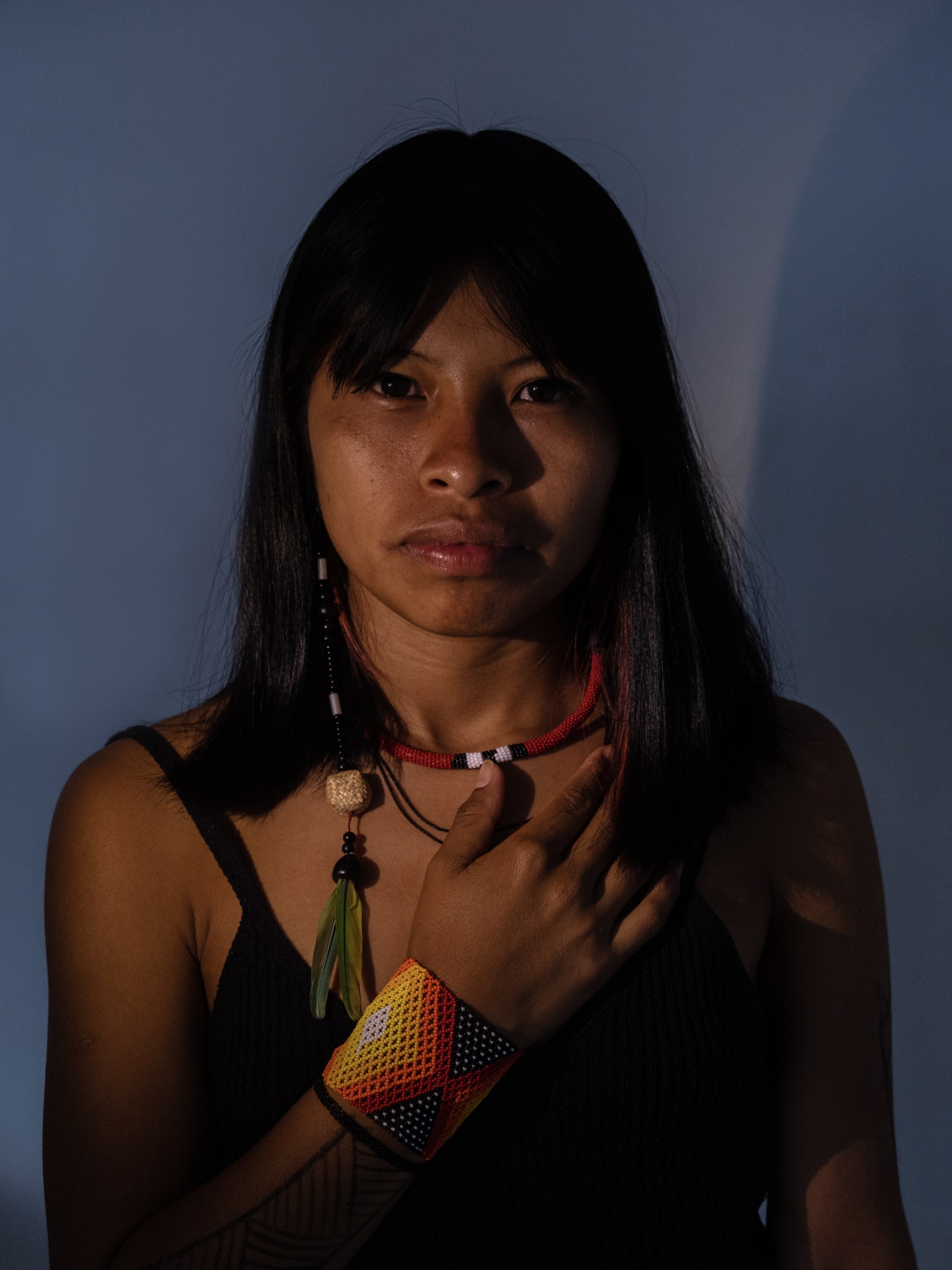
Elida Parayry
21 years old
Communicator of the Guarani Yvyrupa Commission (CGY)
Guarani Mbya People, Paraná
IG: @elida_parayry
“In 2019, I started taking some audiovisual workshops in my village. I liked photography, and as I learned, I used to take pictures of animals and plants with my cell phone. Then I started making records of my grandparents and my parents. As I was learning, I began to accompany the meetings of the indigenous movement.
Communication is a vital tool for the indigenous peoples in this struggle. I think it will be easier to access equipment and connection in the future because it is tough to have a good internet connection right now. Where I live, there is no internet or cell phone signal either.”
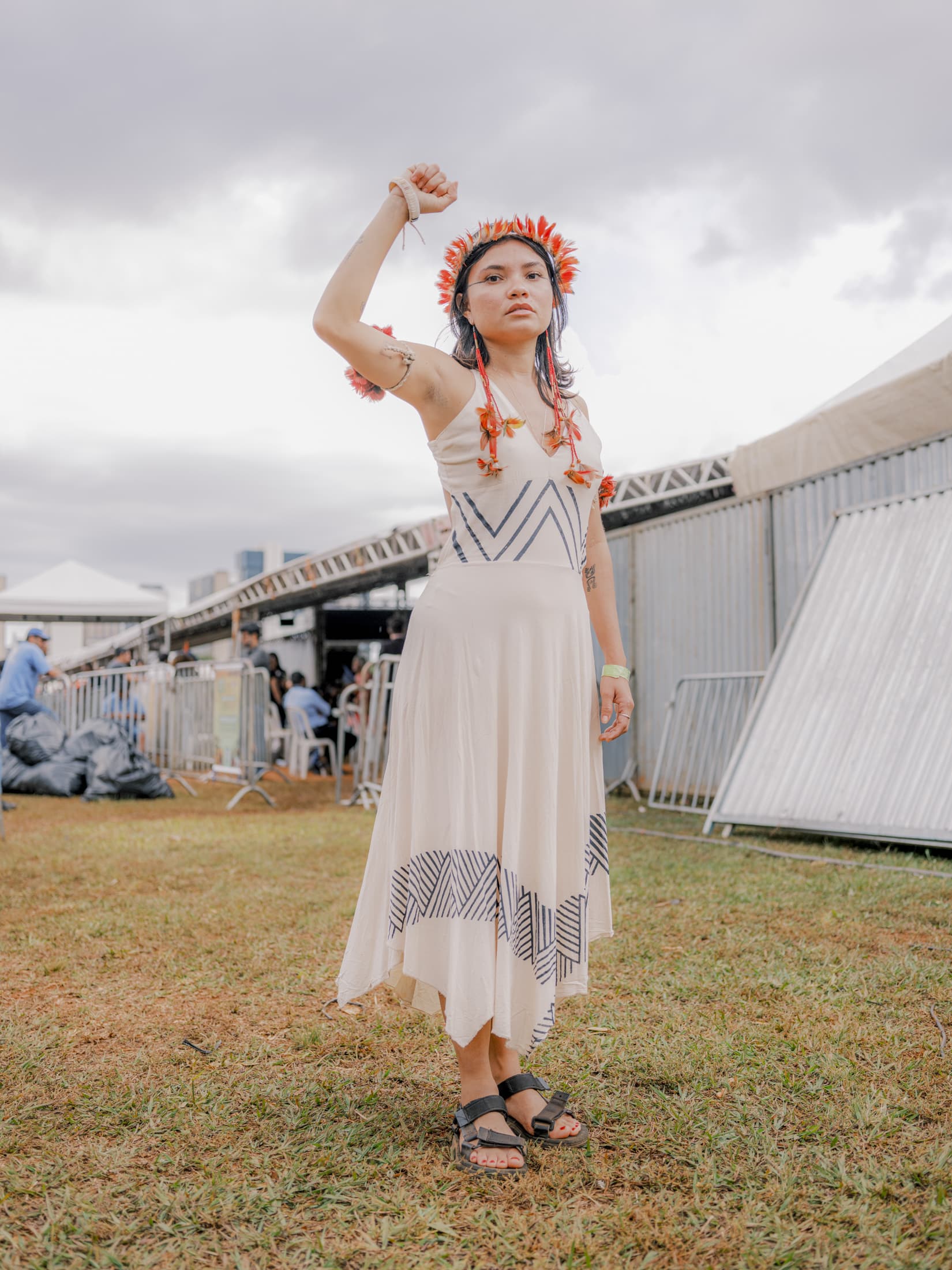
Priscila Tapajoara
30 years old
Filmmaker and Coordinator of Indigenous Cinema at Mídia Indígena
Tapajós People, Santarém do Pará
“I came to the world of indigenous communication in 2013. Two things encouraged me: although many people talked about the indigenous struggle and showed my region, it was an external look, and I did not feel represented. In addition, that was a period when hydroelectric plants were being built in my region, the Belo Monte and the Tapajós Complex. So, that moment coincided with when I started to actively participate in the movements and use communication to talk about what was happening.
From then on, I started to improve and refine my technological skills and went to São Paulo to study filmmaking. Last year I launched Ãgawaraita, a miniseries of 4 chapters that are like short films. Through these short films, I try to show our spirituality to break stereotypes and prejudices about our sacred spirits, which for many people, are simply legends. I recently worked as assistant director and producer of the feature documentary Amazônia a Nova Minamata by Jorge Bodanzky, about mercury contamination in several Amazonian indigenous communities.
I also work at Mídia Indígena. We changed the name because we have already restricted and delimited our space in the independent press. Now we use the correct word with which they should call us and with which we want the young people being formed to identify themselves.”